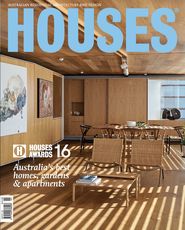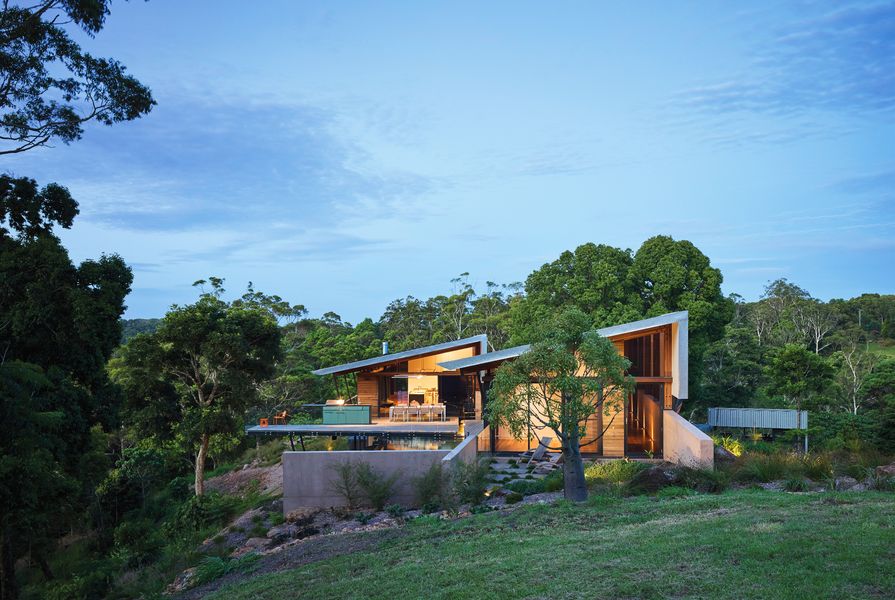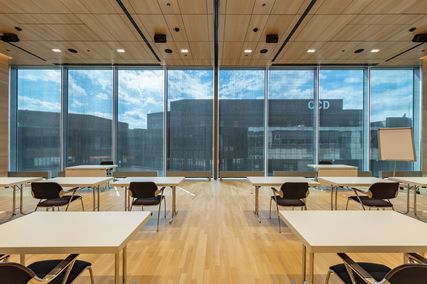A dreamy landscape that had all the hallmarks of a neglected and arca ne botanical garden was the starting point for this house in the Sunshine Coast hinterland. Architect Dan Sparks was entranced by the park-like arcadia, a former banana plantation that stretches twenty-five acres.
“I’d never seen a property quite like it,” he says. The journey from the front gate to the homestead is taken on a winding driveway rolling over hills, over manicured lawns and past pockets of rainforest, ponds replete with black swans and a waterfall, all edged by eucalyptus bushland.
“It’s a kind of Lost World. It is lovely to move through all these layers to arrive at the top of a ridge and such a commanding view of a lake beyond. The sudden full view of the water is spectacular.”
Clearly, the site for the home was to be on this vantage point of a ridge running north–south. The spine of land affords views west to one edge of Lake Baroon nestled between converging hills and ridges in the middle distance, with an inky backdrop of the Conondale Range.
Long open spaces crowned by soaring beams and shaded by deep overhangs reference the farm sheds of an owner’s heritage.
Image: Christopher Frederick Jones
Capturing the view, despite the harshness of the western aspect, was a given. Sparks Architects designed two independent but connected pavilions that are skewed slightly in plan. The main north–south pavilion that takes up a dress-circle position is devoted to the owners’ living and sleeping quarters, with a wine cellar, storage and amenities downstairs. The second, smaller pavilion twists slightly to run southwest–northeast. The tilt allows increased privacy between the pavilions as well as affording more opportunities for occupants to capture views. It houses guest bedrooms and bathrooms, and a study.
“We played with the plan quite a bit on site, pegging out the rooms and standing in each space to ensure they were all getting a different view or ‘moment,’” says Dan. In the process, the original position was shifted a good three metres downhill toward the north, where a grove of ghost gums is framed by the main bedroom and a remnant camphor laurel fills the picture window of the study.
A broad dining deck narrows into a poop deck, the angles of its balustrades drawing focus to the mountains.
Image: Christopher Frederick Jones
The angle established by the offset pavilions forms a central entry canyon that tapers as it reaches the point of arrival. Guests are drawn into the arrow-like shape, starting at a broad ground platform of planting and sculptures. As the stairs ascend, the wedge narrows, so that arrival between the pavilions is on a timber landing flanked by water troughs and a wet-edge lap pool. The strong, angled perspective lines that draw visitors into the entry canyon are also at play in the western perspective. Here, a broad dining deck narrows into a poop deck suspended over the slope. The angles of its balustrades converge in the distance, carefully arranged to focus on a landmark bluff on the mountainside. The entry sequence provides a sense of drama, where the final big statement view is kept concealed as visitors navigate the path between the pavilions.
The main living wing is suspended from the ridge, forming a long sling of space that engages with the panorama. A layer of automated exterior sunblinds protects the open-plan living/dining/kitchen area from afternoon sun. A long skinny deck, “the sheep’s run,” sits half a metre below the interior floor level so that view lines are uninterrupted by verandah rails. Above, a lineal skylight shoots along the length of the galvanized metal roof, washing light over the walls and highlighting the details of the portal frame, expressed steel joints and rammed earth walls.
The two pavilions, skewed slightly in plan, are independent from one another yet connected.
Image: Christopher Frederick Jones
One of the owners hails from Colorado and the other from a sheep station in Western Queensland, and Sparks Architects has respected their heritages in the materiality and tectonics of the home. There’s a memory of the farm shed in the long open spaces crowned by soaring beams and shaded by deep overhangs. Rock walls evocative of the Colorado mountain huts dear to one owner’s childhood memories were found to be too expensive. Instead, rammed earth became the material of choice for a series of spinal walls that anchor the home solidly to the ground. Shaved to a 300-millimetre depth to align with the portal frame columns, they perform well thermally while also forming part of the minimalist, organic palette. Slots of sashless glazing sit between the rammed earth and the folded roof line. The slots are placed at the owners’ eye levels and form a guided circulation path by which to navigate the building. Along the way, sections of the wall push out into day beds or small porches, breaking up the monumentalism of the eastern walls.
Products and materials
- Roofing
- Lysaght Trimdek, galvanized; Colorbond flat sheets in ‘Monument’; trafficable glass with Solar Shield finish; hardwood shiplap cladding.
- External walls
- Rammed earth; CSR fibre cement sheets; hardwood shiplap cladding.
- Internal walls
- Gyprock EC08 plasterboard; Rockcote smooth set render; rammed earth.
- Windows
- AGS Commerical Glass range windows in powdercoated aluminium.
- Doors
- Lockwood Lever 32 doorhandles in satin stainless steel; AGS Commerical Glass doors in powdercoated aluminium.
- Flooring
- Spotted gum floorboards; lightly honed clear-sealed concrete; Ceramica Senio tiles; Ecofleece thermal insulation ceiling blankets; spotted gum decks with Cutek finish.
- Lighting
- Deltalight NoBody 200 pendant; Hunza E-Lite recessd downlight.
- Kitchen
- CDK Stone Neolith basalt benchtop; Blum doors and drawer hardware; custom joinery; Lago Double Bowl Sink; Franke Flexible spray mixer; Teknobili soap dispenser; Billi water unit; Miele coffee machine, steam combination oven and warming drawer.
- Bathroom
- Rogerseller Tonic mixer; Apaiser Altlantis basin; Nikles Techno shower; Kado towel rail, Axa H10 basin and Uno toilet, all from Reece; Sussex Pol Wall Bath Set; Mizu plug and waste; Rogerseller Mero shower.
- Heating and cooling
- Oblica Gyrofocus fireplace.
- External elements
- C&B Timbers timber totems; pavers by Crosby Concrete Products pavers; rock steps by Parton Excavations; Eco Outdoors recycled steel fire dish.
Credits
- Project
- Ridge House
- Architect
- Sparks Architects
Peregian Beach, Qld, Australia
- Project Team
- Dan Sparks, Jon Warton, Michael Cornish
- Consultants
-
Builder
Jaicon Constructions
Energy consultant Anderson Energy Efficiency
Engineer Tate Professional Engineers
Interior design Sparks Architects, Zooi Design
Landscaping Sparks Architects, Conlon Group, Living Style Landscapes
- Site Details
-
Location
Sunshine Coast Hinterland,
Qld,
Australia
Site type Rural
Site area 10000 m2
Building area 352 m2
- Project Details
-
Status
Built
Completion date 2015
Design, documentation 12 months
Construction 14 months
Category Residential
Type New houses
Source

Project
Published online: 12 Dec 2016
Words:
Margie Fraser
Images:
Christopher Frederick Jones
Issue
Houses, July 2016

























